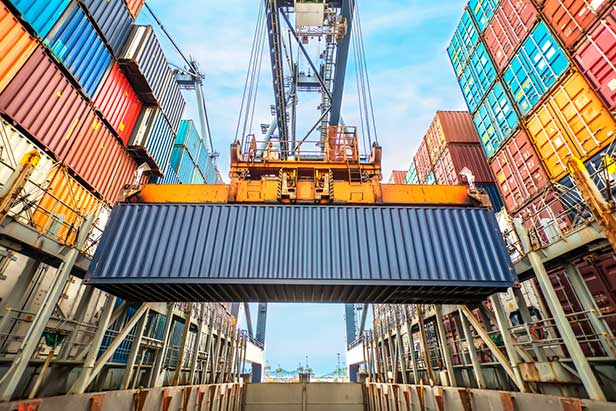News January 21, 2021
Promo Price Increases Loom Due to Importing Woes
Shipping challenges and rising raw material costs are poised to drive product price hikes, as COVID lockdowns threaten promo supply chains in China.
Call it a perfect storm.
A complex concoction that includes skyrocketing shipping container costs, rising raw material prices, reduced shipping capacity and logjammed ports, much of it fallout from the COVID-19 pandemic, is creating an international sourcing nightmare for North American promotional products importers and fueling the potential for price increases on a gamut of products.
Are prices on #promoproducts going to increase in 2021? There’s a high likelihood of it. Here’s why in 62 seconds. @Melissa_ASI @asicentral @ASI_MBell @MeganErber pic.twitter.com/ktVJs5YU6T
— Chris Ruvo (@ChrisR_ASI) January 21, 2021
The challenges could intensify in the coming weeks as the calendar builds toward China’s Lunar New Year on Feb. 12 , and as authorities in Beijing re-institute strict societal lockdown measures in parts of the country to corral coronavirus spread amid a recent reemergence of new COVID cases.
“It’s been one thing after another,” said Jeffrey Nanus, president of Norwood, NJ-based hard goods promo supplier AAA Innovations (asi/30023).
Shipping Expenses Surge
Factories in China manufacture the majority of promo products sold in North America, with other countries outside the U.S. and Canada also producing many items for the market.
One of the biggest current challenges facing suppliers who import product, as well as distributors that source direct from overseas, is the availability of shipping containers to transport product from those international locales to domestic shores.
The containers are essential. They store items that are carried from China, or other countries, on ships to the U.S. and Canada. Only now, there’s a critical dearth of containers, and the scarcity is sending prices for available containers through the stratosphere.
 “We have seen container costs rise 25% to 35%, depending on the lane and the carrier,” said Andrea Lara Routzahn (pictured), senior VP of portfolio and supplier management at Trevose, PA-based alphabroder (asi/34063), the second largest supplier in the promo industry.
“We have seen container costs rise 25% to 35%, depending on the lane and the carrier,” said Andrea Lara Routzahn (pictured), senior VP of portfolio and supplier management at Trevose, PA-based alphabroder (asi/34063), the second largest supplier in the promo industry.
It’s been worse for Nanus.
In recent months, AAA Innovations had been paying a contract rate of about $3,000 per container to ship from China to California and about $4,000 per container to ship from China to New York. Now, the supplier is paying $8,000 to $9,000 for California-bound containers and more than $10,000 for New York-bound ones.
“We’ve had quotes as high as $12,000 per container – that’s crazy,” Nanus said. “No one is honoring contract rates. It’s the first time in my 29 years in this business that I’ve seen anything like this.”
Routzahn said the competition for containers is fierce, resulting in locked-in contract rates being tossed aside and the containers going to those willing to pay elevated rates. Alphabroder has worked diligently to consistently identify the most affordable options via these “spot buy” transactions. Still, what some termed opportunism among container providers appears to be rampant, critics maintained. “Some carriers,” said Routzahn, “are offering a premium service to lock in rates which require customers to commit to monthly usage commitments whether they ship or not.”
A number of factors are causing the container shortage. A key one is that it’s taking longer for empty containers to be returned for refilling. For instance, the average turnaround time for containers returning to China was 100 days in December, up from the usual 60 or so days, according to the China Container Industry Association. The slow return is a consequence, in part, of it taking longer to deliver and unload containers, which has resulted from labor shortages and pandemic health-and-safety protocols that slow the process down.
“Containers are taking longer to unload at port of entry,” said Cheron Coleman, alphabroder’s VP of global supply chain. “Then they’re taking longer to get to their final consignee destinations due to domestic rail and long haul shortages, and they’re taking longer to unload at consignee warehouses due to warehouse labor issues. Finally, empty containers are taking longer to get back to the ports to head back to origin.”
Relatedly, it’s more difficult for importers to secure a spot for containers on a delivery ship.

As Nanus and other import experts explained, shippers shelved portions of their fleets in 2020 as demand plummeted amid the global economic crisis that the pandemic caused. Since then, demand has rebounded robustly, especially for goods made in and exported from China, which in November logged a record trade surplus of $75 billion. Still, shippers haven’t returned their fleets to pre-pandemic levels, which has put space on available ships at a premium, Nanus said.
“The growth in exports, combined with the reduction in ocean carrier capacity, has created a situation where there is simply not enough shipping capacity to meet demand,” said David Nicholson, president of New Kensington, PA-based Polyconcept North America (PCNA; asi/78897), the fourth largest supplier in the promo industry.

“Given the increased shipping costs and the likelihood of buying price increases, there is a high probability that suppliers will need to consider price increases at some point in 2021.” – David Nicholson, PCNA
Nicholson continued: “As a result, carriers are taking advantage by putting through price increases – with shippers desperate to get inventory replenished willing to pay just about anything to get their orders out.”
As Nicholson and others explained, there’s always a mad dash among importers to get product from China stateside before the Lunar New Year in February, which typically sees factories in China close for a couple weeks, with workers often traveling to see family.
This customary surge in market demand has exacerbated the challenges related to container and shipping capacity issues, and comes as some importers scramble more than usual ahead of the Lunar New Year, as they’re worried that COVID-related health-and-safety initiatives tied to the travel of factory workers could lengthen how long factories close and/or operate below peak capacity.
“We’ve heard that some factories could close earlier than normal for this time of year,” said Nanus, though he noted AAA Innovations’ factory partners are fully operational.
An alternative to ocean shipping is air freight. However, that’s a more expensive option – one that’s become even more so. “We’ve seen air freight more than triple,” said Nanus. “Normally, we’d be at about $3 per kilogram. We’ve paid up to $10.” He noted that, as of Wednesday, Jan. 13, the rates were in the neighborhood of $4.80 to $5. Even so, there’s volatility in the market, and rates are subject to increasing again.
Container availability and insufficient shipping capacity have caused promo products to arrive after expected in-hands dates and, in instances, miss the deadlines by which they were required by distributors’ end-clients. Nanus described a situation in which the shipping issues resulted in not being able to meet such a deadline for a distributor. AAA Innovations communicated the reasons, and the distributor called the end-client to explain.
“The end-client laughed and said that was the 12th call he’d gotten on the issue of product not making it in time from overseas,” Nanus said.
Suppliers said the freight woes could remain an issue throughout 2021, especially if demand intensifies amid societal re-openings, which business leaders are banking on as vaccinations potentially inoculate broad swaths of the population against COVID-19.
“There are simply not enough containers coming back to China, with import volumes lagging behind the export growth,” said Nicholson. “And, as the U.S. economy begins to recover mid-2021, things could get worse before they get better.”
Raw Material Costs Rising; Promo Product Prices Could Follow
Raw materials are another component of a product’s total cost that’s increasing for suppliers.
Nanus, for instance, noted that costs for the metals and woods necessary to make the products he sells have increased between 5% and 8%.
“With the rebound of oil prices and other raw materials, along with moves in the Chinese currency rate, we’re beginning to hear of pricing pressure from Chinese producers,” said Nicholson.
Things could get more complicated.
On Wednesday, Jan. 13 the U.S instituted a ban on all cotton from Xinjiang, as well as all products made with cotton from that region of China, because of extensively documented use of forced labor there.
#Xinjiang cotton & products made from it are now banned in the US. That could impact supply chains, drive price increases & influence product preference in #promoproducts space https://t.co/vLI7hu9n2u @ASI_MBell @Tim_Andrews_ASI @asicentral
— Chris Ruvo (@ChrisR_ASI) January 14, 2021
Many in promo and the apparel/textile world believe the ban was made for the right moral/ethical reasons and are on board with it. Still, the ban stands to potentially drive up cotton prices.
Xinjiang produces about 20% of the world’s cotton and 84% of China’s supply, according to some estimates. China is the world’s third-largest cotton-producing nation, behind India and the United States. Removing Xinjiang from the cotton equation reduces the cotton supply available to U.S. apparel and textile companies, and their overseas factory partners, at a time when cotton prices were already rising.
Paltry crop yields, resulting from insufficient rain, are among the factors spurring a rise in the price of cotton. The Wall Street Journal reported that cotton prices recently rose to their highest level in nearly two years, noting that the most-active cotton futures contract was at a point up 55% from when prices bottomed out on April 1, 2020, amid the early days of the pandemic.
Ultimately, higher prices for cotton and other raw materials, combined with sharply steepened shipping costs, could drive price increases on promotional products that range from apparel to umbrellas and everything in between.
#WSJWhatsNow: Cotton prices have risen amid dry weather and concerns of forced labor in China https://t.co/wshU7SGZFx pic.twitter.com/0vYhg6kL3D
— The Wall Street Journal (@WSJ) January 5, 2021
“Given the increased shipping costs and the likelihood of buying price increases, there’s a high probability that suppliers will need to consider price increases at some point in 2021,” said Nicholson. “Obviously, there remains sensitivity to the fact that our industry is still in a period of recovery, so how aggressively suppliers pass along these costs will be a question. However, there’s little doubt suppliers will be facing a number of challenges regarding gross margins.”
Ballparking an “average” increase would be misleading, asserted Nanus, because actual rises could depend largely on both materials in a product and the product’s size. In his opinion, larger items stand to see more noticeable increases. That’s in part a result of the rising container costs. Consider, he said in a hypothetical scenario, that if you can fit thousands upon thousands of small items in a container, you can better spread the container cost increase over those items. But if you can only fit a few hundred items in the container, each particular item has to carry more of the container cost in its price tag.
“Because we’ve pre-sold goods at a certain price, we’ve already had to take it on the chin because our costs soared after the fact,” said Nanus. Looking ahead, “we are planning increases. It doesn’t mean we’re passing everything along, of course, but we have to account for some of the cost pressures we’re facing. Everyone is raising prices.”
China’s COVID Reemergence & Promo Supply Chains
In the winter of 2020, authorities in China implemented vast societal lockdown measures to counteract the spread of COVID-19. Those tight restrictions clamped down on factory activity, disrupting global supply chains, including those in the promotional products industry. Now, amid a new flare up of COVID in China, Beijing authorities have placed about 22 million people on lockdown, essentially ordering them to remain in their homes. Further emphasing the situation, on Friday, January 15, reports emerged that Chinese authorities were building a 3,000-unit quarantine facility to deal with a feared overflow of new COVID patients.
More than 22 million people in China have been ordered to remain inside their homes — double the number locked down last January. The country is experiencing its worst coronavirus flare-up since the summer. https://t.co/o27FyfeQ4Z
— The New York Times (@nytimes) January 13, 2021
The move has awakened anxieties among some Western businesspeople who rely on Chinese production to power their industries here. They fear that factory productivity could again be impacted – and there’s at least some evidence those fears could be founded.
Certain promo suppliers tell Counselor that they’ve received communications from Chinese factory partners indicating that disruptions are in the cards. Suppliers have gotten letters that warn that delays in production and delivery could occur because of COVID-related issues. Those issues could include reduced staff, a potential result of mandated quarantining or actual coronavirus infections, as well as possible temporary factory closures ordered by governmental authorities.
Even so, not every supplier has received such warnings. Executives for such firms noted that their factory partners’ operations have not communicated any pending issues and have not experienced interruptions. “All our partners have integrated mandated COVID protections into their daily operations and are not experiencing any renewed difficulties,” said Routzahn.
Even if there are interruptions, some supplier executives believe that, given current evidence, there will not be a return to the major productivity-damming issues that Chinese factories faced in early 2020. “China’s response last spring and its ability to control the spread of new cases suggests the country should be well-positioned to weather this most recent increase,” said Nicholson.
It’s a prediction promo suppliers, distributors and decorators alike collectively hope will hold true. Nonetheless, the situation bears close watching in the age of COVID, which has made instability the norm and rapid adaptivity essential to business survival.
